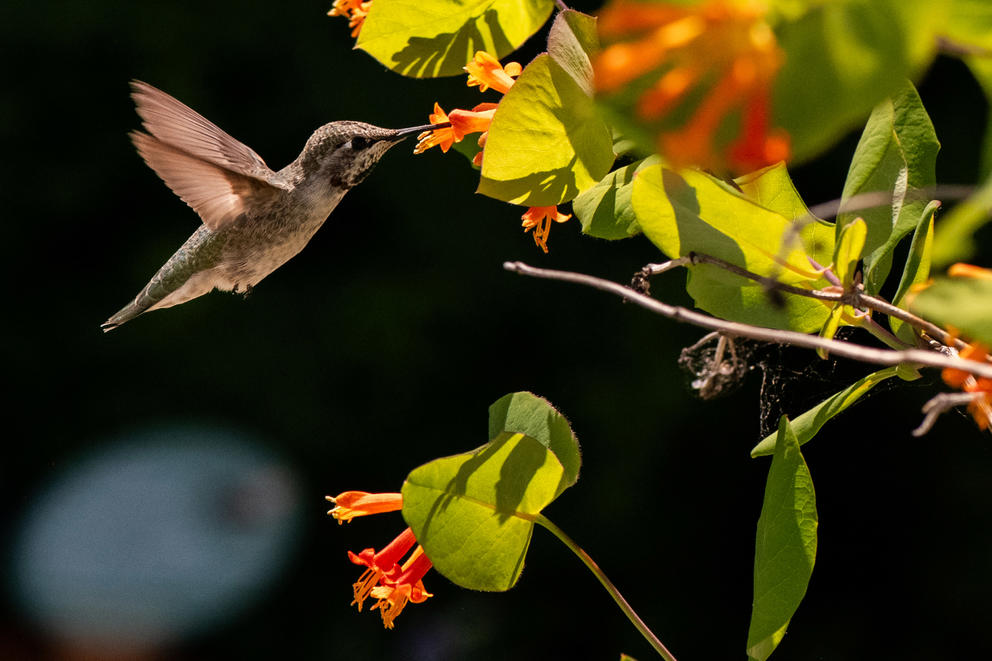The multisensory exhibit, which opened this spring, focuses on the intertwined and cyclical relationships between humans and regional pollinators and introduces a Native-led interpretive approach to the natural world.
The Pacific Science Center (PacSci) in Seattle is refocusing its educational outreach to include more underrepresented communities in STEM (science, technology, engineering and mathematics), presenting an alternative to a predominantly Western perspective. Implementing place-based knowledge, a system that focuses on and is presented by the original stewards of the land, highlights ties to Indigenous culture as well as offers an evolving presentation.
“Sometimes you will see different kinds of birds, different insects, the plants will be in different stages of blooming,” PacSci Marketing Communications Manager Tracy Sawan said. “So it feels like a living, breathing exhibit.”
Along the path, Sawan describes her surroundings as a hummingbird, or t’sin in the Indigenous language Chinuk Wawa, is drawn to a grouping of red flowering currant (Pʰil-tatis).
The Pʰil-tatis produce nectar to attract and feed the t’sin, who in turn move pollen from plant to plant. Pollinator Path invites visitors to learn about their environment through observation — what Oliver describes as a “call to relationship.”
“I was thinking about how we can bring people to understand their relationship with nonhuman kin, nonhuman kin being plants and animals,” said Oliver. “The key point in the Pollinator Path is that call to relationship.”
Oliver descends from the people of the Lower Columbia River, Salish Sea, and Southwest Pueblos.
He grew up attending Seattle Public Schools and graduated in 2021 from the University of Washington with a degree in American Indian studies and political science.
During school trips to the PacSci as a child, Oliver noted an absence of Native knowledge in the exhibits. He was motivated to create the Pollinator Path as a representation of the Indigenous culture he would have liked to have seen as a kid.
“I like pushing the possibilities of what we can do. A lot of times, for urban Native folks, we’re in survival mode. There’s not a lot of dreaming in these scapes of the built environment,” Oliver said.
Now, beneath the historic PacSci arches, visitors are welcomed into the Pollinator Path by Oliver’s voice. The recording repeats a short introduction by the artist followed by a reading of the native pollinator’s names, translated into Chinuk Wawa, a vocabulary used by Northwest Indigenous traders from various tribes to communicate with each other.
Chinuk Wawa (also known as Chinook Jargon) is composed primarily of four languages, including Old Chinook, Nuu-chaa-nulth, English, and French.
“English is foreign to these lands, but there are other words that create that connection,” Oliver said.
Oliver described the multisensory element as an “act of welcoming” as well as a step toward the language’s revitalization in Seattle. He believes that, as a highly anglicized language, Chinuk Wawa is comfortable for visitors to hear and feel comfortable speaking.
Adopting Native language and names is one step PacSci has taken to create a more inclusive educational program.
“It’s been a challenge and a great learning opportunity for me as someone who was really trained in Western science to learn about other ways of knowing and then be able to share it with our guests and give everyone a more holistic view of how our world works,” said exhibit developer Cailee Smith.
The next stop on this path is a plan to revitalize the area originally designed by Minoru Yamasaki for the 1962 World’s Fair, in what PacSci is calling its Courtyard Project. The courtyard was designed as a temporary exhibit not meant for long-term use. As a result, the pools are drained and the space lacks the grandeur of its original design.
“It’s old but there’s still a lot of heart in there,” Oliver said. “But how can we improve [the courtyard] further by bringing Indigenous people into that conversation?”
The plan includes incorporating natural systems, native plants, and Indigenous people and cultures. The science center is in conversation with Headwater People and Owen Oliver to develop the design.
“There’s a long time of building trust and making sure that our voices are being heard and that we’re being appropriately listened to,” Oliver said.
PacSci is committed to staying true to Yamasaki’s vision while committing to a more inclusive and equitable standard, Sawan said.
“The public has been very excited.” Sawan lifts her hand toward the Pollinator Path as guests stop to immerse themselves in the language and natural life around them. “This is a living example of why it’s so important to hear differing and diverse perspectives.”
Oliver said public involvement is an important step in creating more visibility for Indigenous knowledge systems in art and culture around Seattle. If guests would like to see more of this work highlighted, PacSci encourages visitors to watch for online surveys and contact courtyard@pacsci.org to comment on the new initiatives.
“We can all strive for a stronger connection to place through respecting and uplifting the original stewards of the land,” Oliver said.






